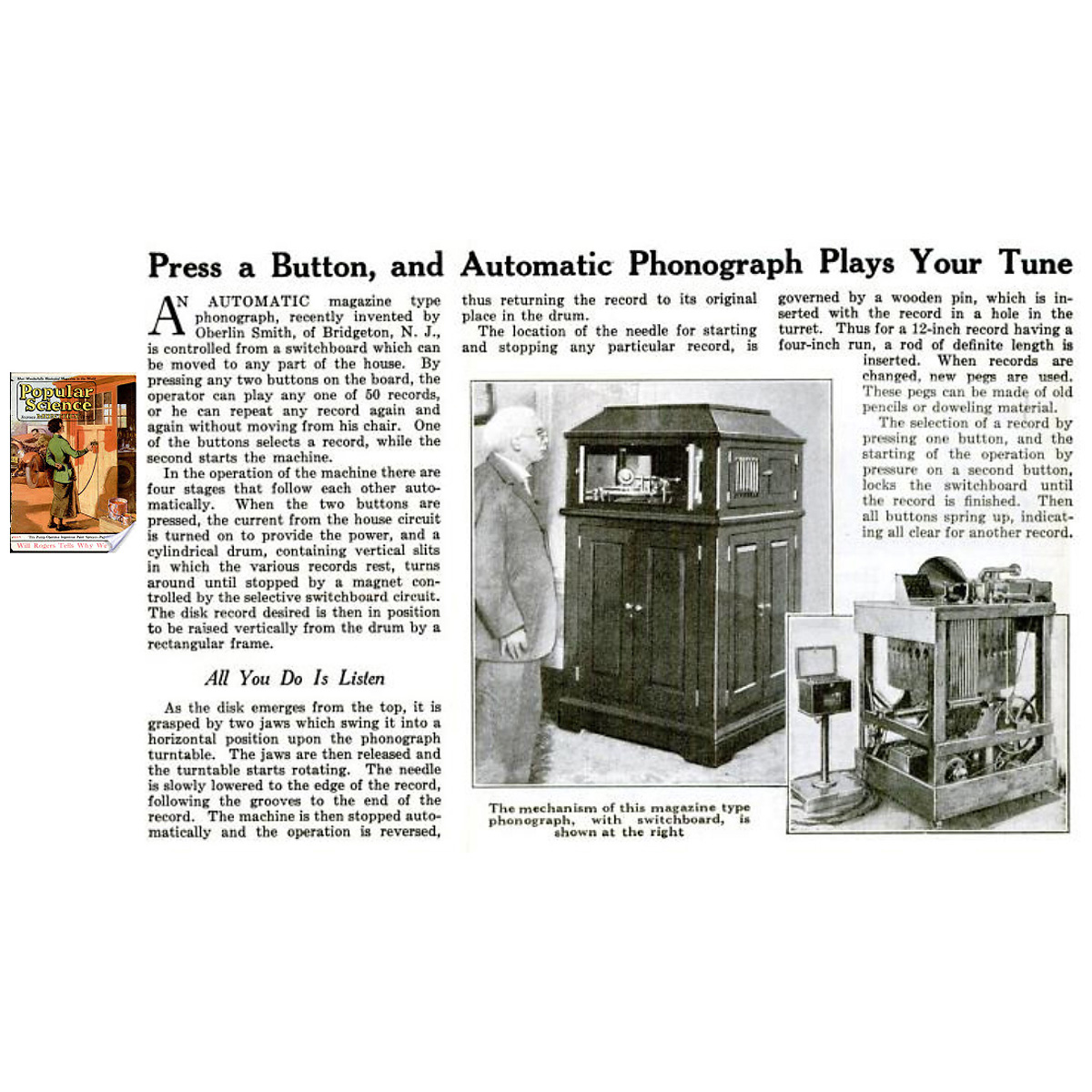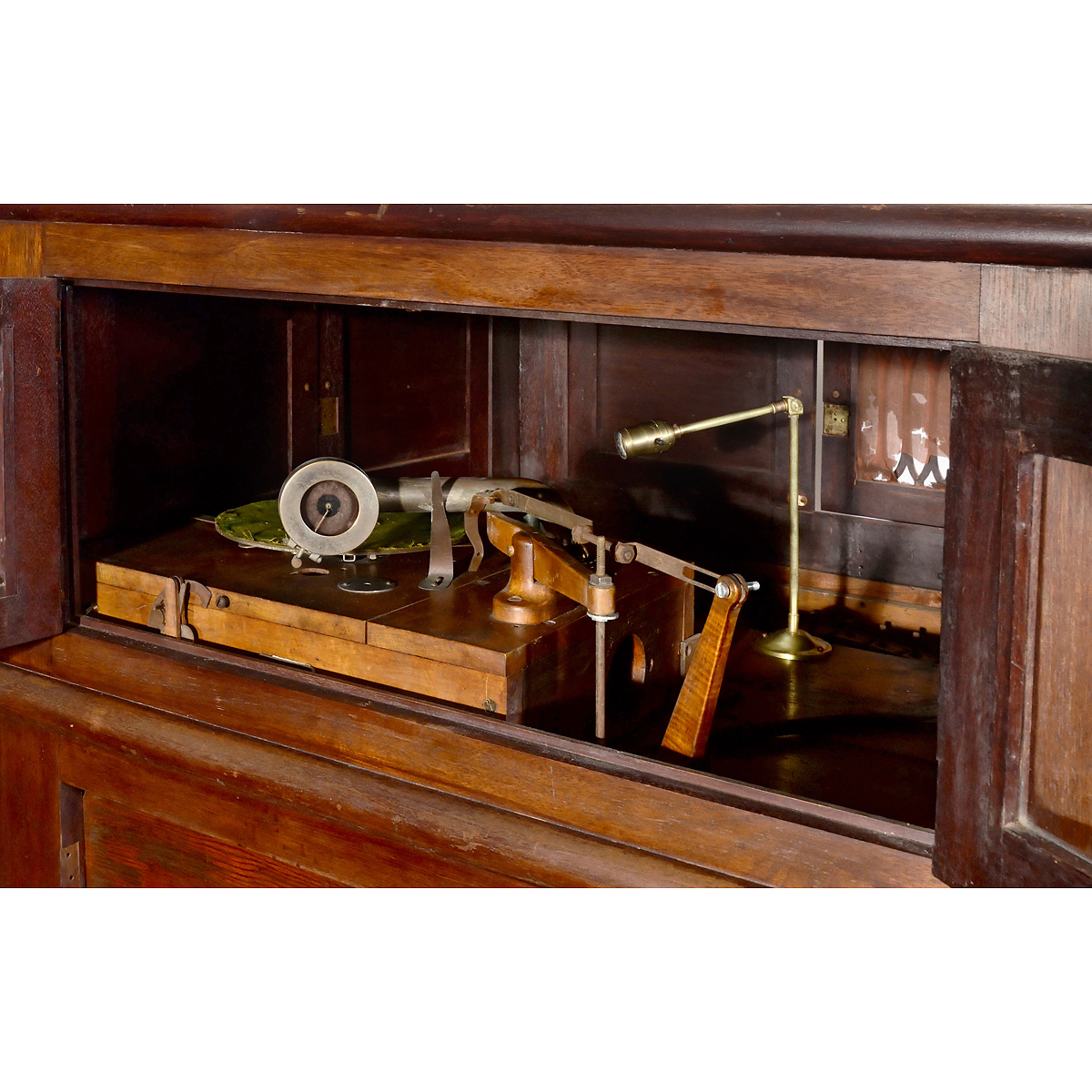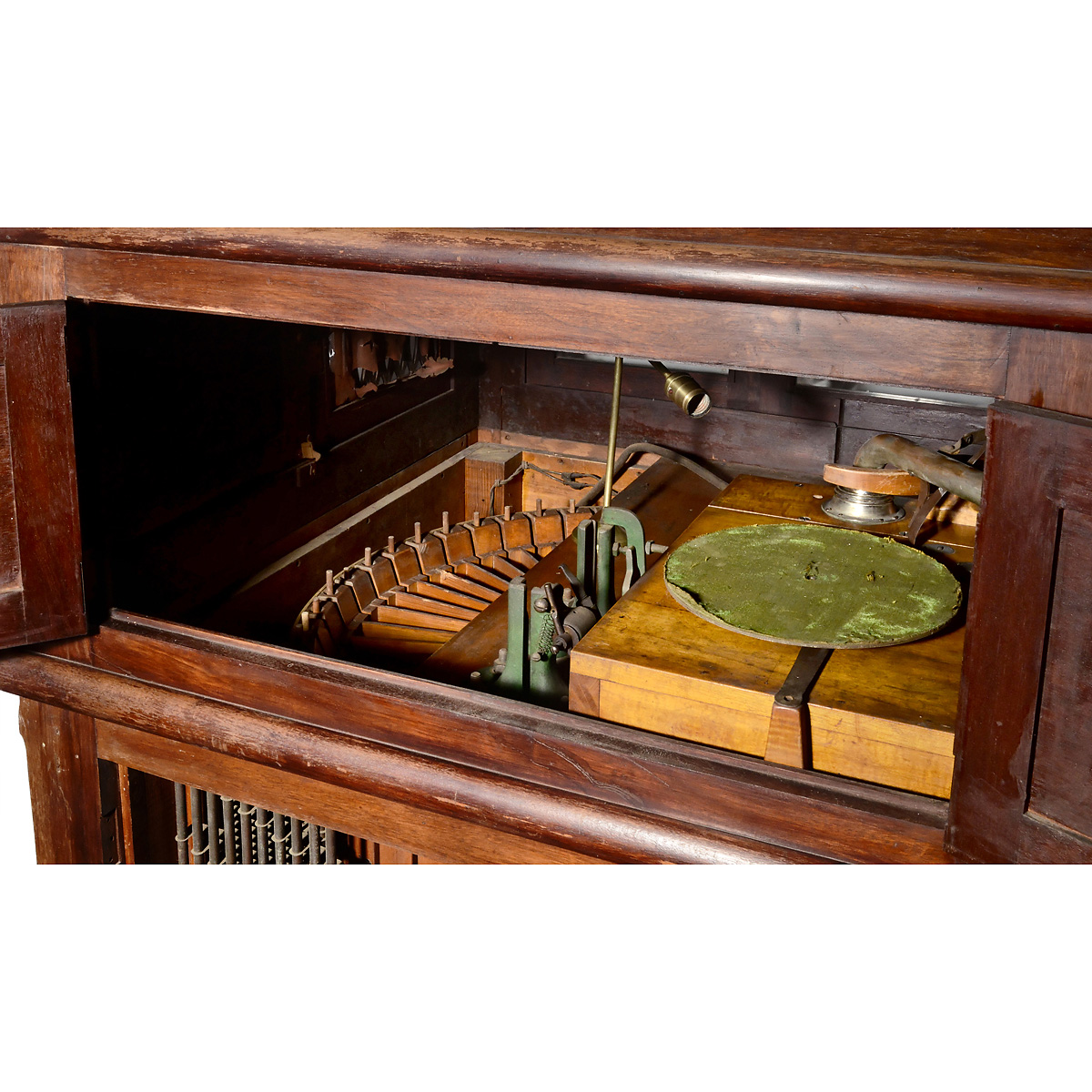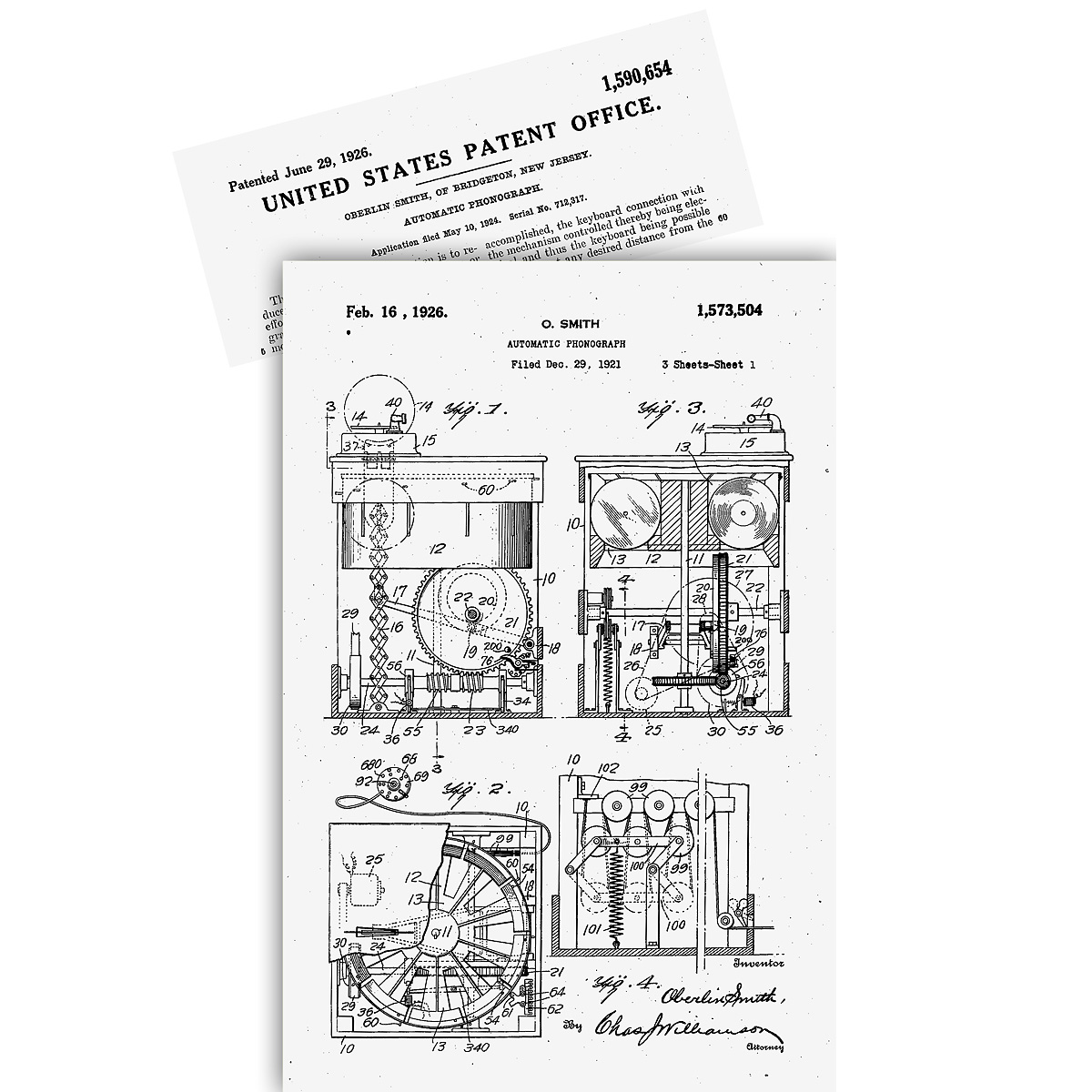






An Historically Important Jukebox Forerunner by the Inventor of
拍品号:20160521-446
预估价:€ 15000-30000 欧元
起拍价:€ 8500 欧元
成交价:
€ 120210 欧元
所属类别:唱片留声机 (Gramophones)
外观成色:-
布雷克拍品等级是为了方便竞买人判断拍卖品的成色而设置的。布雷克等级用1到6级来标注外观和功能的成色,(从非常好到非常差)。
在目录图册里用括号里的2个数字来表示,前一个数字表示外观成色的级别,后一个数字表示功能成色的级别。如(3/2)表示外观成色是3(满意的),功能成色2(好)。
成色 定义参照下列标准: 1 - 非常好 (未使用过,没有使用痕迹) 2 -
好 (新,极少的使用痕迹) 3 - 满意的 (普通的使用痕迹) 4 -
及格的 (明显的使用痕迹,某个非主要部件是后配的) 5 - 有缺陷的 (极明显的使用痕迹,
某个主要部件是后配的,功能上有缺陷,需要修理) 6 - 非常差 (严重破损, 缺少重要部件)
功能成色:-
布雷克拍品等级是为了方便竞买人判断拍卖品的成色而设置的。布雷克等级用1到6级来标注外观和功能的成色,(从非常好到非常差)。
在目录图册里用括号里的2个数字来表示,前一个数字表示外观成色的级别,后一个数字表示功能成色的级别。如(3/2)表示外观成色是3(满意的),功能成色2(好)。
成色 定义参照下列标准: 1 - 非常好 (未使用过,没有使用痕迹) 2 -
好 (新,极少的使用痕迹) 3 - 满意的 (普通的使用痕迹) 4 -
及格的 (明显的使用痕迹,某个非主要部件是后配的) 5 - 有缺陷的 (极明显的使用痕迹,
某个主要部件是后配的,功能上有缺陷,需要修理) 6 - 非常差 (严重破损, 缺少重要部件)
制造商:
制造年份:
序列号:
拍品描述
Oberlin Smith and the Genus of Magnetic Recording: Oberlin Smith was born in Cincinnati, Ohio, but spent most of his adult life in Bridgeport, New Jersey, where he established a business designing dies and presses. The Ferracute Machine Co., incorporated in 1877, built presses for hundreds of metal products from artillery shells to the first commercial oil cans, stamping out components for Packards, Winchester rifles and Kodak cameras. Through his work, Smith came into contact with inventors such as Thomas Edison and Alexander Graham Bell. – In 1877 Thomas Edison gave the first public demonstration of his tinfoil phonograph for recording and reproducing sound mechanically. Smith travelled to Edison's laboratory to see and hear the device in person. – Smith was disturbed by the scratching noises and by the limited length of the recording medium. Less than a year later, he filed two improvements to the phonograph and a provisional description of an electrical phonograph with the Cumberland County Clerk in a memorandum dated 23rd September 1878 and on 4th October 1878 filed a caveat at the United States Patent Office. – The first of improvement was to record phonograph signals on a long wire stored on reels, enabling extended pieces of music to be recorded. The second was to store the sound as a magnetic signal on a silk or cotton thread impregnated with metal powder. – According to Smith, his form of magnetic recording would produce "a perfect record of the sound, far more delicate that the indentations in the tin-foil of the mechanical phonograph". Smith continued to experiment with magnetic recordings over the next decade, publishing his ideas in an article titled "Some Possible Forms of Phonograph" in the influential "Electrical World" journal on 8th September 1888. – Despite Smith's prior work in the field, the Danish inventor Valdemar Poulsen (1869–1942) was credited as the first person to achieve magnetic sound recording with operational, mass-produced equipment. Poulsen filed a patent for a "method of recording and reproducing sound or signals" by "magnetically exciting paramagnetic bodies" on 8th July 1899. The patent was granted on 13 November 1900 and unveiled to the public with a recording of Kaiser Franz Joseph's voice at the Paris Exposition of the same year. – Poulsen certainly knew of Smith's work as the 1888 article from "Electrical World" was cited during the patent grant procedure, however Smith received no public credit from Poulsen. Smith reacted to Poulsen's omission by laying retrospective claim to the invention of magnetic recording in an application to U.S. Commissioner of Patents in Washington in November 1900. However, as he head filed only a caveat (and not a patent) in 1878, his claim was not taken seriously. – Not only did Smith's work raise the idea of a recording telephone, it also paved the way for developments in universal magnetic storage of sound, images and data still in use more than one hundred years later. Without Smith, much of today's magnetic recording technology – from the hard-drive to the magnetic strips of credit cards – would not have been possible. Smith's Last Invention: The Autofono – "All You Do is Listen …" Despite his disappointments in the field of magnetic recording, Smith did not give up his experiments with magnetic technology. On 29th December 1921, Smith filed a patent application for an "Automatic Phonograph". – "The main object of my invention is to reduce to the minimum the manual labor or effort required in the operation of phonographs and other instruments of entertainment ... Another object is to enable the application of the sound record ... by the manipulation of a controlling device, such as a keyboard, situated more or less remote from the instrument." – The patent was finally granted on 16th February 1926 and a second patent for an improved version, filed on 10 May 1924, was granted on 29th June 1926. Despite the lengthy application process, the "Autofono" had already been described and photographed with its inventor in the May 1923 edition of "Popular Science". – According to the article's author, the 'magazine-type phonograph' could be controlled by a portable switchboard from any part of the house. The operator simply selected any of the fifty records, changed it or repeated it, without having to move from his chair. Two buttons on the switchboard regulated four stages of operation: the current from the house circuit is turned on, the slotted drum is set in motion, the drum rotates until stopped by a magnet, the desired disc is then raised into position by a vertical frame, swung into a horizontal position and then lowered onto the turntable by a pair of jaws. The switchboard is then locked until the record has finished playing, after which the machine is stopped automatically and the operation reversed. – In the Autofono, Smith created the first fully automatic recordplayer, anticipating the first jukebox by some seven years. Sadly, once again, Oberlin Smith was to receive little credit for his invention. The death of the 86-year-old inventor in 1926 prevented the commercial application of his Autofono and a fire at his home in 1934 destroyed what is believed to be the only other surviving example. – The Autofono on offer here is in unrestored, original non-functioning condition. The boxy flat-topped machine seen here is definitely the first model (of 1921); the second model from 1924 had slimmer proportions and a rounded top. – A fantastic restoration project and historically important museum exhibit! References: 1) Jean Jones, "The Story of Oberlin Smith", The News, 24th June 2006, pp. A6–7. – 2) "Oberlin Smith and the Invention of Magnetic Recording", Philadelphia Enquirer, 29 December 1988. – 3) Auction Team Breker, 16 November 2013, Lot 56, for information on Poulsen's "Telegraphone". – 4) Popular Science, May 1923, p. 47. – 5) Friedrich Karl Engel (ed.) "Oberlin Smith and the Invention of Magentic Sound Recording, An Appreciation on the 150th Anniversary of the Inventor's Birth", January 1990, revised July 2006. – For additional autobiographical details of Oberlin Smith, please see www.Breker.com/NewHighlights.
成色说明
布雷克拍品等级是为了方便竞买人判断拍卖品的成色而设置的。布雷克等级用1到6级来标注外观和功能的成色,(从非常好到非常差)。
在目录图册里用括号里的2个数字来表示,前一个数字表示外观成色的级别,后一个数字表示功能成色的级别。如(3/2)表示外观成色是3(满意的),功能成色2(好)。
成色 定义参照下列标准: 1 - 非常好 (未使用过,没有使用痕迹) 2 -
好 (新,极少的使用痕迹) 3 - 满意的 (普通的使用痕迹) 4 -
及格的 (明显的使用痕迹,某个非主要部件是后配的) 5 - 有缺陷的 (极明显的使用痕迹,
某个主要部件是后配的,功能上有缺陷,需要修理) 6 - 非常差 (严重破损, 缺少重要部件)
发表评论

